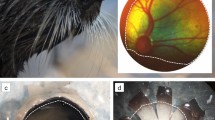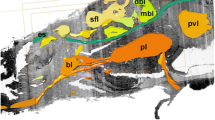Summary
The extent to which the cephalopod eye is optically similar to the teleost eye was determined by measuring refractive error, accommodative ability, spherical and chromatic aberrations, and refractive indices and radii of curvature of the ocular media. The squid eye is well corrected optically underwater although a tendency toward hyperopia exists. This may be due to the existence of chromatic aberration and the fact that an aquatic environment is somewhat limited to the blue end of the spectrum. Accommodation takes place by movement of the lens toward the retina in a manner similar to the teleost eye. However, the squid lens is not spherical but slightly flattened. The lens is overcorrected as far as spherical aberration is concerned. Thus peripheral light rays focus further from the lens than paraxial ones. The function of this unusual example of lens development is unknown.
Similar content being viewed by others
References
Alexandrowicz JS (1927) Contribution à l'étude des muscles, des nerfs et du méchanisme de l'accommodation de l'oeil des céphalopodes. Arch Zool Exp Goén 66:71–134
Beer T (1897) Die Akkommodation des Kephalopodenauges. Pfluegers Arch 67:541–586
Bennett AG, Francis JL (1962) Visual optics. In: Davson H (ed) The eye, vol IV. Academic Press, New York, pp 1–107
Charman WN, Tucker J (1973) The optical system of the goldfish eye. Vision Res 13:1–8
Heine L (1907) Über die Verhältnisse der Refraktion, Akkommodation und des Augenbinnendruckes in der Tierreihe. Med Naturwiss Arch 1:323–344
Hess C (1905) Beiträge zur Physiologie und Anatomie des Cephalopodenauges. Pfluegers Arch 109:393–439
Muntz WRA (1977) Pupillary response of cephalopods. Symp Zool Soc (Lond) 38:277–285
Packard A (1972) Cephalopods and fish: the limits of convergence. Biol Rev 47:241–307
Pumphrey RJ (1961) Concerning vision. In: Ramsay JA, Wigglesworth VB (eds) The cell and the organism. Cambridge University Press, London, pp 193–208
Sadler JD (1973) The focal length of the fish eye lens and visual acuity. Vision Res 13:417–423
Sroczynski S (1975) Die sphärische Aberration der Augenlinse der Regenbogenforelle (Salmo gairdneri Rich). Zool Jahrb Physiol 79:204–212
Sivak JG (1978a) A survey of vertebrate strategies for vision in air and water. In: Ali MA (ed) Sensory ecology. Plenum, New York, London, pp 503–519
Sivak JG (1978b) Optical characteristics of the eye of the spiny dogfish (Squalus acanthias). Rev Can Biol 37:209–217
Sivak JG, Bobier WR (1978) Chromatic aberration of the fish eye and its effect on refractive state. Vision Res 18:453–455
Verrier ML (1933) Réfraction statique de l'oeil des Céphalopodes. CR Acad Sci (Paris) 196:1435–1437
Wald G (1960) The distribution and evolution of visual systems. In: Florkin M, Mason HS (eds) Comparative biochemistry, vol I, Sources of free energy. Academic Press, New York, pp 311–345
Walls GL (1942) The vertebrate eye and its adaptive radiation. Cranbrook Institute of Science, Bloomfield Hills, Michigan
Wells MJ (1978) Octopus; physiology and behaviour of an advanced invertebrate. Chapman and Hall, London
Author information
Authors and Affiliations
Rights and permissions
About this article
Cite this article
Sivak, J.G. Optical properties of a cephalopod eye (the short finned squid,Illex illecebrosus). J. Comp. Physiol. 147, 323–327 (1982). https://doi.org/10.1007/BF00609666
Accepted:
Issue Date:
DOI: https://doi.org/10.1007/BF00609666




